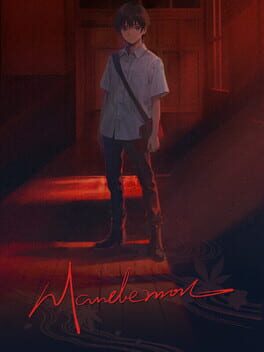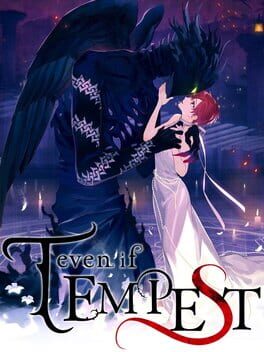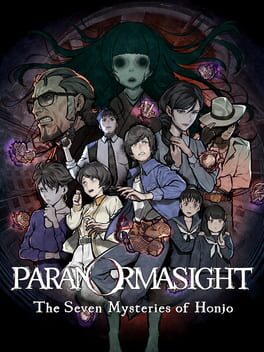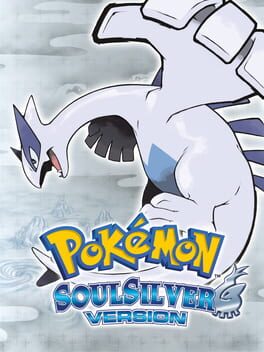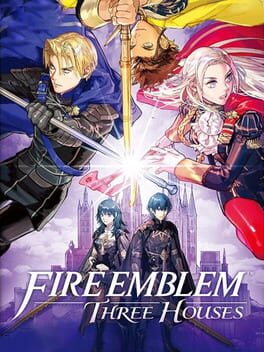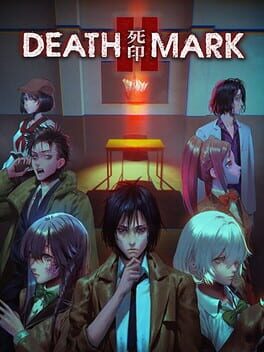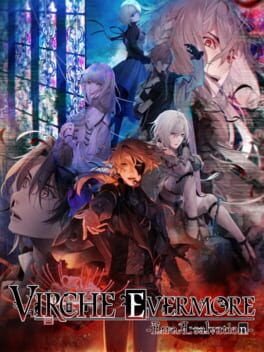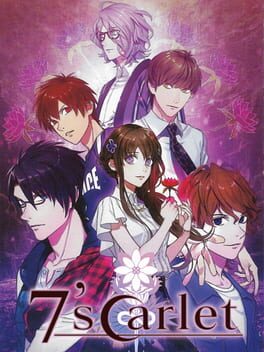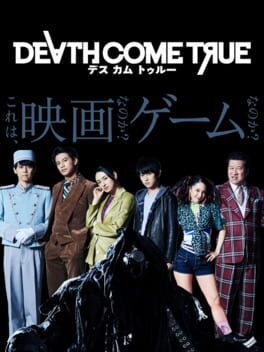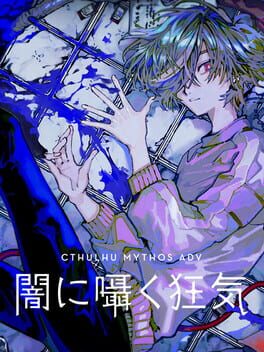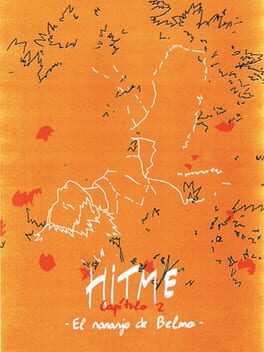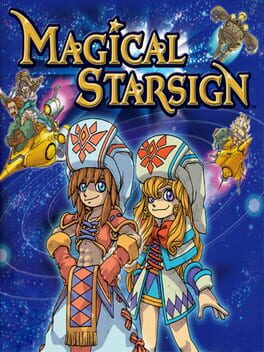almorica
2023
It's fine.
Benefits: gorgeous art and nice character designs, largely unpredictable story, pleasant piano soundtrack, easy Steam achievements, skip to choice button, Minamoto is a babe
Drawbacks: sometimes poetic and sometimes pronoun-scrambling sort of translation, noticeably more visual variation for male character designs, some requirements for endings are not intuitive, it may be a bit short (3-7 hours) to land its resolution
(Warning for a rape scene that is not visually described or depicted, as well)
Benefits: gorgeous art and nice character designs, largely unpredictable story, pleasant piano soundtrack, easy Steam achievements, skip to choice button, Minamoto is a babe
Drawbacks: sometimes poetic and sometimes pronoun-scrambling sort of translation, noticeably more visual variation for male character designs, some requirements for endings are not intuitive, it may be a bit short (3-7 hours) to land its resolution
(Warning for a rape scene that is not visually described or depicted, as well)
2022
I didn't have much faith that the full game would satisfyingly wrap up the immense amount of misery the intro kicks up, but it really, really does. Not a game you really want to play for the romance (especially if you want to see a kiss with the game cover monster, like I know plenty did when it was announced), but a game that commits to the story it's telling and the characters it loops through again and again.
My main problem is that it has more gameplay than your standard VN, but it was wholly unfun to actually play. Definitely play something like GNOSIA instead if you want a engaging Werewolf simulator. It also crashed on me more than a dozen times, generally tripping up in specific spots for some reason.
And it's nice that the best explanation for "why" a specific thing is the way it is is "character's trans". Always positive in my book.
My main problem is that it has more gameplay than your standard VN, but it was wholly unfun to actually play. Definitely play something like GNOSIA instead if you want a engaging Werewolf simulator. It also crashed on me more than a dozen times, generally tripping up in specific spots for some reason.
And it's nice that the best explanation for "why" a specific thing is the way it is is "character's trans". Always positive in my book.
2019
SwSh are games with a lot of flash and little substance. I played Shield concurrently with a replay of Soulsilver, and it made how little there actually is to do in Galar glaringly obvious. Complete a gym, do a rival battle, run to the next gym, do another rival battle, and repeat almost without rest all the way to the Champion battle. What happened to quaint side locations like Sprout Tower or the game corner or even a department store?
It was nice to look at while I played it, but the story was thin, the characters got little depth (outside of Bede), and the gameplay loop got boring early on and never really mixed it up. I can't really recommend it for more than the visual experience of First Pokémon Entry On The Switch -- and Centiskorch, I guess!
It was nice to look at while I played it, but the story was thin, the characters got little depth (outside of Bede), and the gameplay loop got boring early on and never really mixed it up. I can't really recommend it for more than the visual experience of First Pokémon Entry On The Switch -- and Centiskorch, I guess!
Misery-inducing. Too much of the game is people just standing around talking or sitting around talking, and not even in a comfy visual novel way. Every 10 seconds they'll stop talking until you make a few selections to prompt them or someone else to continue, making "conversations" feel disjointed and padded out.
These conversations tend to happen in wide open 3D spaces, too, and the spacious environments make it even more awkward that the characters rarely ever make use of them outside of the prologue. They just. Stand around. In big parks and on big bridges. This is another way the game would benefit from actually being a visual novel: a static 2D background would make it less obvious that they're wasting so much stage space.
Moving along in the main story is constantly hampered by a need to hit a specific trigger in another route. It's not just one or two big locks preventing your progress, like in a reasonable game – you hit a wall in nearly every scene if you’re unlucky and have to hop back and forth until you find who unlocks what.
These technical annoyances exist to allow cool meta twists and puzzles to happen once in a while, which cannot excuse how tedious it is the rest of the time.
The pacing is wild. The prologue is blisteringly fast, and the rest is agonizingly slow. And the most villainous forces in the game die off-screen, never show up in person at all, or never personally reveal their motivations. They’re all unsatisfying.
What I can admire in this game is the art style and that it gives you everything you need to solve the mysteries and guess the plot twists ahead of time. Unfortunately, figuring it all out miles ahead of the characters made it even worse to watch them just stand around talking 10 seconds apiece. But for someone who doesn't guess it all (and did enjoy the game), the amount of foreshadowing would probably make a second playthrough pretty neat.
These conversations tend to happen in wide open 3D spaces, too, and the spacious environments make it even more awkward that the characters rarely ever make use of them outside of the prologue. They just. Stand around. In big parks and on big bridges. This is another way the game would benefit from actually being a visual novel: a static 2D background would make it less obvious that they're wasting so much stage space.
Moving along in the main story is constantly hampered by a need to hit a specific trigger in another route. It's not just one or two big locks preventing your progress, like in a reasonable game – you hit a wall in nearly every scene if you’re unlucky and have to hop back and forth until you find who unlocks what.
These technical annoyances exist to allow cool meta twists and puzzles to happen once in a while, which cannot excuse how tedious it is the rest of the time.
The pacing is wild. The prologue is blisteringly fast, and the rest is agonizingly slow. And the most villainous forces in the game die off-screen, never show up in person at all, or never personally reveal their motivations. They’re all unsatisfying.
What I can admire in this game is the art style and that it gives you everything you need to solve the mysteries and guess the plot twists ahead of time. Unfortunately, figuring it all out miles ahead of the characters made it even worse to watch them just stand around talking 10 seconds apiece. But for someone who doesn't guess it all (and did enjoy the game), the amount of foreshadowing would probably make a second playthrough pretty neat.
Final team: Meganium, Gengar, Golem, Politoed, Raikou, and Lugia.
SoulSilver/HeartGold is the most ideal Pokemon game to date, as far as features go. It’s not perfect: the story and characters are barebones; Pokemon move pools are more limited than they are in more recent gens; there are too many water-type HMs; and the level of wild Pokemon is way too low in late-game, forcing you to do things like grind for a level 45-50 battle on level 32 Pokemon.
But, it’s rich in content otherwise:
- There’s a full second region to explore after you complete the game’s home region
- Your lead Pokemon follows you around on the map and has a huge variety of text reactions based on friendship level and location
- Different Pokemon and activities are available based on time of day and day of the week, as opposed to seasons or unpredictable weather variations
- There are interesting places to visit either in every town or nearby (that aren’t just a gym)
- There are fun NPC interactions and rematches through the in-game phone
- Great art direction
- A varied, solid soundtrack only limited by the DS hardware
- Apricorns are available as a method of collecting more Pokeballs without spending money
If they ever combined the better end of modern graphics, characters, storytelling, and movesets with this level of content (and stability), it really would be perfect.
SoulSilver/HeartGold is the most ideal Pokemon game to date, as far as features go. It’s not perfect: the story and characters are barebones; Pokemon move pools are more limited than they are in more recent gens; there are too many water-type HMs; and the level of wild Pokemon is way too low in late-game, forcing you to do things like grind for a level 45-50 battle on level 32 Pokemon.
But, it’s rich in content otherwise:
- There’s a full second region to explore after you complete the game’s home region
- Your lead Pokemon follows you around on the map and has a huge variety of text reactions based on friendship level and location
- Different Pokemon and activities are available based on time of day and day of the week, as opposed to seasons or unpredictable weather variations
- There are interesting places to visit either in every town or nearby (that aren’t just a gym)
- There are fun NPC interactions and rematches through the in-game phone
- Great art direction
- A varied, solid soundtrack only limited by the DS hardware
- Apricorns are available as a method of collecting more Pokeballs without spending money
If they ever combined the better end of modern graphics, characters, storytelling, and movesets with this level of content (and stability), it really would be perfect.
After clearing two routes (Black Eagles, Golden Deer) at 290 hours, I feel like I can properly talk about this.
It's a good game. After the rather weak political struggle in Fates, 3H goes hard on crafting an intricate and morally layered conflict that splits into four paths to follow. The story has its problems, but it puts its whole heart into what it's got, making it easier to miss or forgive the flaws. It's also got good visual presentation and endearing characters to recruit.
I think the most likely experience with the four routes is that the first one will feel like your real story, while any further playthroughs will have more ideal armies, thanks to the New Game Plus features. They let you continue a completed save file with various things, like your Renown, and allow you to spend that Renown to automatically raise a character's skill level to S or level their support with Byleth to A. You'll also have a better idea of how to teach your units the second time around, probably. I got through Black Eagles just fine, but my 10 fliers in Golden Deer were another story entirely.
The biggest problem with the four route system is that a significant chunk of every single one of them is exactly the same. If you feel like playing several or all of them, White Clouds may just drive you nuts. After that, though, there was enough story variation between the two I completed that it felt worth it. There were plot revelations in each that didn't come up in the other one.
This is definitely the most dense FE I've played, and that was to its detriment at times. Sometimes it felt really padded out that one chapter's main battle didn't just lead into the next one (especially at the end of Golden Deer!), and even spending the month on Skip doesn't make it go by that quickly. Prepare to either not think much and not recruit many characters, or spend a lot of time deciding how to teach your units and bonding with them around the monastery. Maybe that'll even be more fun to you than the chapter finales?
I liked it a lot, ultimately, when I felt like it wasn't just wasting my time. I would love to know how much of my 290 hours was just waiting on loading screens, though. I'm sure it'd be horrific.
It's a good game. After the rather weak political struggle in Fates, 3H goes hard on crafting an intricate and morally layered conflict that splits into four paths to follow. The story has its problems, but it puts its whole heart into what it's got, making it easier to miss or forgive the flaws. It's also got good visual presentation and endearing characters to recruit.
I think the most likely experience with the four routes is that the first one will feel like your real story, while any further playthroughs will have more ideal armies, thanks to the New Game Plus features. They let you continue a completed save file with various things, like your Renown, and allow you to spend that Renown to automatically raise a character's skill level to S or level their support with Byleth to A. You'll also have a better idea of how to teach your units the second time around, probably. I got through Black Eagles just fine, but my 10 fliers in Golden Deer were another story entirely.
The biggest problem with the four route system is that a significant chunk of every single one of them is exactly the same. If you feel like playing several or all of them, White Clouds may just drive you nuts. After that, though, there was enough story variation between the two I completed that it felt worth it. There were plot revelations in each that didn't come up in the other one.
This is definitely the most dense FE I've played, and that was to its detriment at times. Sometimes it felt really padded out that one chapter's main battle didn't just lead into the next one (especially at the end of Golden Deer!), and even spending the month on Skip doesn't make it go by that quickly. Prepare to either not think much and not recruit many characters, or spend a lot of time deciding how to teach your units and bonding with them around the monastery. Maybe that'll even be more fun to you than the chapter finales?
I liked it a lot, ultimately, when I felt like it wasn't just wasting my time. I would love to know how much of my 290 hours was just waiting on loading screens, though. I'm sure it'd be horrific.
Death Mark II dares to ask the question we’ve all been wondering: what if, after improving the series with NG, they made a Spirit Hunter entry where everything got worse?
Amateurish sidescrolling environments and character animations instead of the spooky, heavily detailed visual novel screens of the previous two games?
Live or Die situations but your chances of succeeding, even if you pick the right choice, are randomly generated?
Spirit encounters where your options are so limited it’s easy to pick the right one, but far more boring than the Death Mark and NG encounters because of it?
Sidelining new characters for the sake of using the Mark Bearers as the protagonist’s partners?
Constant back-and-forth exploitation of the misery (for player discomfort) and physical bodies (for player horniness) of teenage girls?
I can’t even say I was ever really scared as a player or absorbed by the intense atmosphere of the game, so everything I loved about Death Mark is out, and everything I found distasteful is in. Although the first Death Mark could get very horny about female bodies in horror situations, somehow they made it feel even worse in this game. It doesn’t help that almost all of these exploited bodies are of high schoolers.
Only one of the spirits in the game is male. His body is only a source of terror, and his backstory is the least explored. The rest are used for as much misery as possible, definitely adequately explaining their grudges, but also going over the top in depicting what someone with the role of “girl” in society can go through and (of course) resolving it with the violent deaths that made them a spirit.
Plus, if there’s a situation where they can make a living or dead female body sexy while they’re suffering, you can bet they’re going for it in this game. More than once the protagonist was about to see something “scary” and I could immediately predict how undressed the victims were going to be. I don’t know — it felt consistently disrespectful of situations they wanted to call terrible, scary violations of human rights. After NG went waaaay down on the horror-horny, I had decent hopes for this game that were crushed early and decisively.
At least I’ll always have the first two games to go back to. As for Death Mark II, I can’t say I’d recommend it to anyone. It sufficiently made me feel gross, but never afraid.
Amateurish sidescrolling environments and character animations instead of the spooky, heavily detailed visual novel screens of the previous two games?
Live or Die situations but your chances of succeeding, even if you pick the right choice, are randomly generated?
Spirit encounters where your options are so limited it’s easy to pick the right one, but far more boring than the Death Mark and NG encounters because of it?
Sidelining new characters for the sake of using the Mark Bearers as the protagonist’s partners?
Constant back-and-forth exploitation of the misery (for player discomfort) and physical bodies (for player horniness) of teenage girls?
I can’t even say I was ever really scared as a player or absorbed by the intense atmosphere of the game, so everything I loved about Death Mark is out, and everything I found distasteful is in. Although the first Death Mark could get very horny about female bodies in horror situations, somehow they made it feel even worse in this game. It doesn’t help that almost all of these exploited bodies are of high schoolers.
Only one of the spirits in the game is male. His body is only a source of terror, and his backstory is the least explored. The rest are used for as much misery as possible, definitely adequately explaining their grudges, but also going over the top in depicting what someone with the role of “girl” in society can go through and (of course) resolving it with the violent deaths that made them a spirit.
Plus, if there’s a situation where they can make a living or dead female body sexy while they’re suffering, you can bet they’re going for it in this game. More than once the protagonist was about to see something “scary” and I could immediately predict how undressed the victims were going to be. I don’t know — it felt consistently disrespectful of situations they wanted to call terrible, scary violations of human rights. After NG went waaaay down on the horror-horny, I had decent hopes for this game that were crushed early and decisively.
At least I’ll always have the first two games to go back to. As for Death Mark II, I can’t say I’d recommend it to anyone. It sufficiently made me feel gross, but never afraid.
I have to hand it to Virche for its sheer confidence in itself: it expected me to complete over 50 hours of reading, a full repeat of the game’s lengthy introduction, and all routes before giving me a single good ending. And clearly, I did that. I played this game to the point of viewing all endings, CGs, and text.
My impression was lukewarm at the start — even quite negative at times — but the big and little mysteries and their assorted clues that started piling up kept my attention. It really does give you just about everything you need to guess what the truths are behind the story, and I respect that too. I picked up on a lot of them, but I was very pleasantly surprised that I missed things and eventually got caught off guard as well.
Virche does rely a lot on pseudoscience, however. If you try to predict the story based on real-world facts, good luck. It’s best to just roll your eyes and move on when these things come up, considering it threatened to take me out of the story several times. The world of Virche does whatever the hell it wants with terms and biological realities, and you’re just along for the ride!
While it’s common for otome games, I have to voice my usual problem: where are the girls and women? Why doesn’t the protagonist get a female friend/acquaintance her age? There are so many recurring male characters with sprites, including non-love interests, and only two female characters. The female characters that do exist, sprite or not, get quite the unpleasant treatment by the narrative. While they suffer plenty too, the male characters get far more agency to work with.
The protagonist is one of those suffering, struggling girls, and she may or may not make the experience tough for you. To be blunt, she’s a deeply depressed doormat. Her backstory justifies her willingness to accept a lot of abuse, but it could be unpleasant to watch for certain players. And she gets a lot of abuse from so many characters (including love interests, whether they want to do it or not), from verbal abuse to physical violence to murder.
The romance may also be hit-or-miss. The love interest could be a lot older than the protagonist, or someone she calls her brother, or this or that other questionable spoiler thing. They are heavy romances, to be sure, filled with suffering and very little sweetness or spice, but still a whole lot of devotion to the protagonist. As dark tales (rather than something to dream of), they work.
I have mixed feelings on Virche’s approach to love and how people feel it, but I do give it two thumbs up for including a significant male character with feelings for another male character that is never the target of homophobic abuse. They all have bigger problems, fortunately(?).
As for my experience physically playing the game, there were only scattered typos in the text that didn’t intrude much, and it generally flowed well. I hated the way the screen would go bright white before and after every flashback, though; I probably already remembered what happened in the past and didn’t need to get blinded while being reminded of it. Getting different endings was often more tedious than it needed to be, sometimes seemingly requiring the entire route to be skipped through again to enable a different one to happen.
I appreciated the skip-to-choice button, as slow as it could be sometimes; the easy to access and understand flowchart; the gorgeous CGs; and the clear, definitive “you’re headed for a bad ending” screen effect it did most of the time that was going to happen. It makes the screen all glitchy for a few seconds, which is really difficult to miss.
The music deserves an honorable mention as well. While not something I’d listen to outside of the game, it really works in context.
My recommendation: play Virche Evermore if you want some truly wild and tragic times with beautiful male characters.
My impression was lukewarm at the start — even quite negative at times — but the big and little mysteries and their assorted clues that started piling up kept my attention. It really does give you just about everything you need to guess what the truths are behind the story, and I respect that too. I picked up on a lot of them, but I was very pleasantly surprised that I missed things and eventually got caught off guard as well.
Virche does rely a lot on pseudoscience, however. If you try to predict the story based on real-world facts, good luck. It’s best to just roll your eyes and move on when these things come up, considering it threatened to take me out of the story several times. The world of Virche does whatever the hell it wants with terms and biological realities, and you’re just along for the ride!
While it’s common for otome games, I have to voice my usual problem: where are the girls and women? Why doesn’t the protagonist get a female friend/acquaintance her age? There are so many recurring male characters with sprites, including non-love interests, and only two female characters. The female characters that do exist, sprite or not, get quite the unpleasant treatment by the narrative. While they suffer plenty too, the male characters get far more agency to work with.
The protagonist is one of those suffering, struggling girls, and she may or may not make the experience tough for you. To be blunt, she’s a deeply depressed doormat. Her backstory justifies her willingness to accept a lot of abuse, but it could be unpleasant to watch for certain players. And she gets a lot of abuse from so many characters (including love interests, whether they want to do it or not), from verbal abuse to physical violence to murder.
The romance may also be hit-or-miss. The love interest could be a lot older than the protagonist, or someone she calls her brother, or this or that other questionable spoiler thing. They are heavy romances, to be sure, filled with suffering and very little sweetness or spice, but still a whole lot of devotion to the protagonist. As dark tales (rather than something to dream of), they work.
I have mixed feelings on Virche’s approach to love and how people feel it, but I do give it two thumbs up for including a significant male character with feelings for another male character that is never the target of homophobic abuse. They all have bigger problems, fortunately(?).
As for my experience physically playing the game, there were only scattered typos in the text that didn’t intrude much, and it generally flowed well. I hated the way the screen would go bright white before and after every flashback, though; I probably already remembered what happened in the past and didn’t need to get blinded while being reminded of it. Getting different endings was often more tedious than it needed to be, sometimes seemingly requiring the entire route to be skipped through again to enable a different one to happen.
I appreciated the skip-to-choice button, as slow as it could be sometimes; the easy to access and understand flowchart; the gorgeous CGs; and the clear, definitive “you’re headed for a bad ending” screen effect it did most of the time that was going to happen. It makes the screen all glitchy for a few seconds, which is really difficult to miss.
The music deserves an honorable mention as well. While not something I’d listen to outside of the game, it really works in context.
My recommendation: play Virche Evermore if you want some truly wild and tragic times with beautiful male characters.
2016
7'scarlet shows its age as an Otomate release in both features and structure. It's missing what is now the standard (like a flowchart, affection-up indicators, and skip-to-choice), and the strange way later endings are unlocked and accessed certainly is an experience because of it. It's also really bad at foreshadowing; after playing Virche Evermore and seeing good examples of this, playing 7'scarlet a second time while knowing everything really has no particularly satisfying payoff.
I really like this game, though. It's partially horror and involves some instances of blood, violence and death, but it's one of the coziest games I own. The soundtrack and backgrounds are so comfortable and relaxing the majority of the time. I may not be completely sold on much of the romantic content, but I am sold on the protagonist — with a beautiful design and convincing big puppy dog eyes, I can imagine why these guys would fall for her. It was nice seeing her, Yua, Yuzuki, and Okunezato again!
Anyway, I'm glad this game ends after Yuzuki's endings and there's no secret route whatsoever❤️
I really like this game, though. It's partially horror and involves some instances of blood, violence and death, but it's one of the coziest games I own. The soundtrack and backgrounds are so comfortable and relaxing the majority of the time. I may not be completely sold on much of the romantic content, but I am sold on the protagonist — with a beautiful design and convincing big puppy dog eyes, I can imagine why these guys would fall for her. It was nice seeing her, Yua, Yuzuki, and Okunezato again!
Anyway, I'm glad this game ends after Yuzuki's endings and there's no secret route whatsoever❤️
2020
Fairly inoffensive, but also aggressively not good. Considering Danganronpa's Kodaka was behind this, it could've been a lot more uncomfortable (but the mystery could've been more engaging, too). It's not the worst way to spend a whole couple of hours or less, unless you're epileptic, in which case you might genuinely die from all the erratic light effects.
An RPG maker point-and-click horror game that’s heavy on unsettling vibes, creepy imagery and Lovecraft references, although there’s no need to know Lovecraft well to enjoy it. It has a sanity meter and seemingly a lot of choices with Game Over potential, but it’s really a lot more forgiving than it first appears. There are a lot of Game Over opportunities at the very end, but before then your poor choices and bad dice rolls aren’t that dire (and can even be very interesting!). It’s one of the most chill horror games I’ve experienced because of this, so if you’re looking for that, you’re reading the review for the right game.
(If you still experience a lot of frustration with the dice rolls, it’s possible to get an item toward the end that you can use to manipulate them on a second or later playthrough. Just pay attention to your environment — or look at a guide — to find it!)
The art is fantastic, past the simplistic backgrounds, which do have their own charm. It’s split between several artists that all have their own strengths, which can make certain things seem a little jarring when looked at together (like the style of the character portraits vs the style of the memory image), but each one really accomplished something neat. The characters are cute and the monsters are quite freaky. If anything, I just wish that the couple of characters that are present that only appear as a silhouette had portraits of their own.
The music does what it needs to when it’s there, but isn’t really suited to listening to outside of the game.
As an originally Japanese game, the translation flows naturally and is only sometimes marred by typos, grammatical errors, and missing words. If it was only slightly more polished, I’d call it perfect.
The worst part of the game is how it handles possible branching moments. One character could be with you at point A, but they could also not be with you, so the game doesn’t have them do much (or anything at all). And to get different endings, you will have to go through the same branching points several times with very little variation. At least there’s a skip button, but as a warning, it doesn’t stop at unread text.
Ultimately, it accomplishes what it sets out to do, with only a few limitations likely due to time and budget. And it was quite nice to experience! I think I’ll remember this one and its core cast for a while. I’d recommend it to anyone looking for a mostly relaxed horror game experience, including those looking to play on Steam Deck.
(If you still experience a lot of frustration with the dice rolls, it’s possible to get an item toward the end that you can use to manipulate them on a second or later playthrough. Just pay attention to your environment — or look at a guide — to find it!)
The art is fantastic, past the simplistic backgrounds, which do have their own charm. It’s split between several artists that all have their own strengths, which can make certain things seem a little jarring when looked at together (like the style of the character portraits vs the style of the memory image), but each one really accomplished something neat. The characters are cute and the monsters are quite freaky. If anything, I just wish that the couple of characters that are present that only appear as a silhouette had portraits of their own.
The music does what it needs to when it’s there, but isn’t really suited to listening to outside of the game.
As an originally Japanese game, the translation flows naturally and is only sometimes marred by typos, grammatical errors, and missing words. If it was only slightly more polished, I’d call it perfect.
The worst part of the game is how it handles possible branching moments. One character could be with you at point A, but they could also not be with you, so the game doesn’t have them do much (or anything at all). And to get different endings, you will have to go through the same branching points several times with very little variation. At least there’s a skip button, but as a warning, it doesn’t stop at unread text.
Ultimately, it accomplishes what it sets out to do, with only a few limitations likely due to time and budget. And it was quite nice to experience! I think I’ll remember this one and its core cast for a while. I’d recommend it to anyone looking for a mostly relaxed horror game experience, including those looking to play on Steam Deck.
2022
This is a short visual novel encompassing the first two chapters of the Hitme story, so even though it says "2", you can start here (and the dev even recommends it).
Everything about this feels so carefully crafted to fit a vibe that I feel like any criticism is exactly what the dev was going for. The use of "u" for "you" in the English translation sometimes definitely breaks my immersion, though.
It's a very violent and sweet story about polyamorous gay men and multiple kinds of recovery, so if that concept entices you, I think you'll ultimately have a high opinion of it too. It does have scenes of sexual intimacy and a fair amount of suicidal behavior, in case either one concerns or interests you more.
Everything about this feels so carefully crafted to fit a vibe that I feel like any criticism is exactly what the dev was going for. The use of "u" for "you" in the English translation sometimes definitely breaks my immersion, though.
It's a very violent and sweet story about polyamorous gay men and multiple kinds of recovery, so if that concept entices you, I think you'll ultimately have a high opinion of it too. It does have scenes of sexual intimacy and a fair amount of suicidal behavior, in case either one concerns or interests you more.
2006
An older gem of a game, Magical Starsign does its utmost to achieve style on the DS. It’s beautiful to look at most of the time and at least amusing when it isn’t, and it uses the dual screens to display the environment at times in such a way that I have a hard time imagining it remade for a single-screen (or at least horizontal) device. It took me about 25 hours to complete this time, so it’s on the shorter end of turn-based RPGs.
It’s a spacefaring fantasy, and heavy on the fantasy aspect — the planet designs and general “science” make for some bizarre sci-fi. It’s a lot of fun if you can get past that and just enjoy how much the world commits to weaving together its world under its own cute, clever, and sometimes frightening logic. It’s cohesive, as long as you don’t try to force it to make sense under real-world logic.
(It is absolutely wild how much each planet's dwellers let the main kids get away with just to "rescue their teacher", though.)
In general the battles (mostly random encounters) aren’t that difficult, and I didn’t need to spend much time grinding. You can generally just move from one place to the next, taking down bosses with a little thought put into your strategy. The final boss is a little over the top in difficulty though, considering how long the unskippable cutscene is beforehand. As a warning: do not let the final boss line up the planets. The game does not give you this warning, and finding out what happens if you do allow it is a slow trudge back through that cutscene again. If that sounds fine to you, then hey, go for it.
I’d recommend this game to anyone in the market for a pretty pixel RPG that has a substantial story, but doesn’t take a substantial amount of your time. It’s quirky and a little heartbreaking, and looks excellent on the original DS hardware.
It’s a spacefaring fantasy, and heavy on the fantasy aspect — the planet designs and general “science” make for some bizarre sci-fi. It’s a lot of fun if you can get past that and just enjoy how much the world commits to weaving together its world under its own cute, clever, and sometimes frightening logic. It’s cohesive, as long as you don’t try to force it to make sense under real-world logic.
(It is absolutely wild how much each planet's dwellers let the main kids get away with just to "rescue their teacher", though.)
In general the battles (mostly random encounters) aren’t that difficult, and I didn’t need to spend much time grinding. You can generally just move from one place to the next, taking down bosses with a little thought put into your strategy. The final boss is a little over the top in difficulty though, considering how long the unskippable cutscene is beforehand. As a warning: do not let the final boss line up the planets. The game does not give you this warning, and finding out what happens if you do allow it is a slow trudge back through that cutscene again. If that sounds fine to you, then hey, go for it.
I’d recommend this game to anyone in the market for a pretty pixel RPG that has a substantial story, but doesn’t take a substantial amount of your time. It’s quirky and a little heartbreaking, and looks excellent on the original DS hardware.
